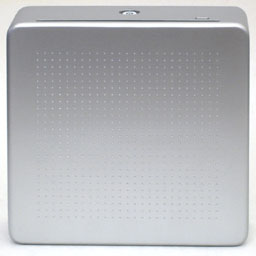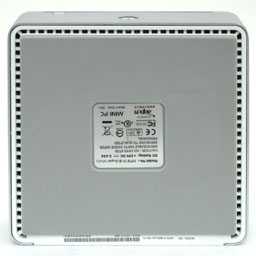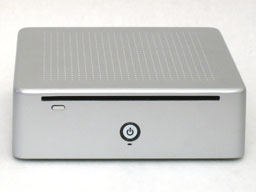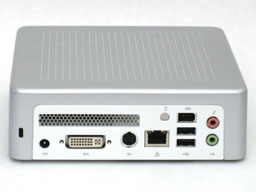Updated: AOpen MiniPC – Imitation is the Sincerest Form of Flattery
by Jarred Walton on March 3, 2006 12:05 AM EST- Posted in
- Systems
Appearance and System Specifications
To say that the AOpen MiniPC looks similar to the Mac Mini is an understatement. AOpen's own product marketing material contains numerous photographs comparing the two. Not everyone thinks that tiny PCs are cool looking or even necessary, but for those who do, the AOpen MiniPC is a very nice looking unit. Depending on where you purchase the MiniPC, you can find them in a variety of colors. Black, white, and silver are the most common, and the unit that we received is silver.
Other than the rear ports and the glowing blue power/HDD lights on the front, the case is a uniform silver. Also found on the front of the unit is the slot-load optical drive access and the accompanying eject button. The top has a grid of small indentations to add a bit of visual flare, while the sides and front are unadorned brushed aluminum. The bottom of the case has a rubberized non-slip pad with venting around the edges and a sticker containing product details, and that's about it. The case is, of course, very small, and you could easily hide it from view if desired, just like the Mac Mini. Technically, the MiniPC is slightly smaller than the Mac Mini (by about .5" in height), but basically, the system size is a tie.
One item that needs to be pointed out is the choice of interface. There are no legacy ports on the system; other than video and audio connections, the only interface for input devices and other components is provided by two USB 2.0 ports. Only two? That's right: if you want more than two devices, you're going to need a USB hub of some form. In fact, since you're going to use a mouse and keyboard for at least one port, a USB hub is almost required for expansion. You might try getting a keyboard with a couple of USB ports, but most likely, they will be USB 1.1, so you won't want to use them for high bandwidth devices. For testing, a Logitech Bluetooth keyboard and mouse combo was used, so that did leave a spare USB port. If you want to do anything more with the MiniPC, grab a powered USB 2.0 hub with at least four ports; they typically cost around $10 to $30, so it's not a major expense.
The Realtek ALC655 audio chip in the unit is capable of 5.1 sound, but apparently lack of room for the audio ports leaves only a speaker/headphone jack and a microphone jack. That should allow for up to 4.1 sound, using the microphone port for the rear/side speakers, but most users will either want 5.1 or 2.1 so the inclusion of only two audio jacks is a definite limitation. The unoccupied spot to the left of the USB/Firewire port is for the WiFi antenna, and it seems like AOpen could have added a third audio jack without too much difficulty, as there is still a bit of open space on the back plate. To the left of the plate you can see the exhaust port for the CPU HSF, and along the bottom are the DVI port, TV-out, LAN, and power sockets.
The TV-out takes an "octopus" adapter that splits the output into S-VIDEO, Component, or Composite, and a DVI to VGA adapter is included in the package. Both the component and DVI connections were tested with an HDTV, and the component was found to be preferable (as the DVI port would lose resolution settings between reboots). Notably lacking is support for S/PDIF output and legacy PS/2 ports for the keyboard and mouse. The audio overall is the weakest link, but the video aspects do help make up for it.
While the size and appearance may be similar to the Mac Mini, the insides are quite different. In typical Wintel fashion, AOpen has cloned the original Mac Mini with a system that is going to be faster in nearly every area. Here are the specifications.
If you're looking for a screaming fast computer, this isn't it. If you want to play a lot of games, once again, you're barking up the wrong tree. Taking all of the functionality in your standard computer and compressing it into a size that's about as big as your typical 5.25" DVD ROM drive requires some compromises. You get integrated graphics, a 2.5" hard drive, DVD burner, a processor and memory... and that's really about it. There is an option to have a WiFi card installed as well. The good news is that there are plenty of applications that don't require anything more than those specs.
One item that we have to clarify is that the system we received came with a Pentium M 740 (1.733 GHz Dothan) processor, and most of the online models as well as AOpen's documentation list the Pentium M 740 as the standard "high-end" processor. However, it appears that the system is capable of running faster CPUs, as there are a few European sites selling the MP915 with up to a Pentium M 760 (2.0 GHz). We didn't encounter any heat-related issues during testing, so other than cost there shouldn't be any reason for the MiniPC to not support the top Pentium M chips.
To say that the AOpen MiniPC looks similar to the Mac Mini is an understatement. AOpen's own product marketing material contains numerous photographs comparing the two. Not everyone thinks that tiny PCs are cool looking or even necessary, but for those who do, the AOpen MiniPC is a very nice looking unit. Depending on where you purchase the MiniPC, you can find them in a variety of colors. Black, white, and silver are the most common, and the unit that we received is silver.
Other than the rear ports and the glowing blue power/HDD lights on the front, the case is a uniform silver. Also found on the front of the unit is the slot-load optical drive access and the accompanying eject button. The top has a grid of small indentations to add a bit of visual flare, while the sides and front are unadorned brushed aluminum. The bottom of the case has a rubberized non-slip pad with venting around the edges and a sticker containing product details, and that's about it. The case is, of course, very small, and you could easily hide it from view if desired, just like the Mac Mini. Technically, the MiniPC is slightly smaller than the Mac Mini (by about .5" in height), but basically, the system size is a tie.
 |
 |
| Click on images to enlarge. | |
One item that needs to be pointed out is the choice of interface. There are no legacy ports on the system; other than video and audio connections, the only interface for input devices and other components is provided by two USB 2.0 ports. Only two? That's right: if you want more than two devices, you're going to need a USB hub of some form. In fact, since you're going to use a mouse and keyboard for at least one port, a USB hub is almost required for expansion. You might try getting a keyboard with a couple of USB ports, but most likely, they will be USB 1.1, so you won't want to use them for high bandwidth devices. For testing, a Logitech Bluetooth keyboard and mouse combo was used, so that did leave a spare USB port. If you want to do anything more with the MiniPC, grab a powered USB 2.0 hub with at least four ports; they typically cost around $10 to $30, so it's not a major expense.
The Realtek ALC655 audio chip in the unit is capable of 5.1 sound, but apparently lack of room for the audio ports leaves only a speaker/headphone jack and a microphone jack. That should allow for up to 4.1 sound, using the microphone port for the rear/side speakers, but most users will either want 5.1 or 2.1 so the inclusion of only two audio jacks is a definite limitation. The unoccupied spot to the left of the USB/Firewire port is for the WiFi antenna, and it seems like AOpen could have added a third audio jack without too much difficulty, as there is still a bit of open space on the back plate. To the left of the plate you can see the exhaust port for the CPU HSF, and along the bottom are the DVI port, TV-out, LAN, and power sockets.
The TV-out takes an "octopus" adapter that splits the output into S-VIDEO, Component, or Composite, and a DVI to VGA adapter is included in the package. Both the component and DVI connections were tested with an HDTV, and the component was found to be preferable (as the DVI port would lose resolution settings between reboots). Notably lacking is support for S/PDIF output and legacy PS/2 ports for the keyboard and mouse. The audio overall is the weakest link, but the video aspects do help make up for it.
While the size and appearance may be similar to the Mac Mini, the insides are quite different. In typical Wintel fashion, AOpen has cloned the original Mac Mini with a system that is going to be faster in nearly every area. Here are the specifications.
| AOpen MiniPC MP915 | |
| Motherboard: | AOpen propietary 915GM+ICH6M |
| Processor: | Intel socket 479 (Celeron M to Pentium M 740) |
| RAM: | 1 X DDR2 SO-DIMM (Maximum 1GB of RAM) |
| Hard Drive: | 2.5" PATA Notebook HDD |
| Graphics: | 915GM (Intel GMA900) |
| Optical Drive: | Slim CD/DVD slot load |
| Expansion Slots: | 1 X Mini-PCI (for WiFi) |
| Audio: | Realtek ALC655 AC'97 2CH (Speaker/Headphones + Microphone) |
| Power Suply: | 65W (19V, 3.5A) External Adapter Internal connections from motherboard to HDD and ODD |
| Front Ports: | None. Power Button, HDD Activity LED, ODD Eject Button |
| Rear Ports: | 2 X USB2.0 2 X 3.5mm Audio (speakers and microphone) LAN (GbE) 1 X DVI-D and 1 X TV-Out (S-VIDEO, Composite, Component) 1 X Optional WiFi Antenna |
If you're looking for a screaming fast computer, this isn't it. If you want to play a lot of games, once again, you're barking up the wrong tree. Taking all of the functionality in your standard computer and compressing it into a size that's about as big as your typical 5.25" DVD ROM drive requires some compromises. You get integrated graphics, a 2.5" hard drive, DVD burner, a processor and memory... and that's really about it. There is an option to have a WiFi card installed as well. The good news is that there are plenty of applications that don't require anything more than those specs.
One item that we have to clarify is that the system we received came with a Pentium M 740 (1.733 GHz Dothan) processor, and most of the online models as well as AOpen's documentation list the Pentium M 740 as the standard "high-end" processor. However, it appears that the system is capable of running faster CPUs, as there are a few European sites selling the MP915 with up to a Pentium M 760 (2.0 GHz). We didn't encounter any heat-related issues during testing, so other than cost there shouldn't be any reason for the MiniPC to not support the top Pentium M chips.












54 Comments
View All Comments
Questar - Friday, March 3, 2006 - link
Where else in the x86 market is Apple not price competetive?rowcroft - Friday, March 3, 2006 - link
Considering it's Friday, the new Mac Mini's were announced on Tuesday (one is on a FedEx truck on it's way to my house) the article really shouldn't have the errors that it does. You can certainly tell Anand didn't write this one....JarredWalton - Friday, March 3, 2006 - link
There are a couple places where I mention the fact that this has already been superceded by the new Mac Mini. Considering this product is less than two months old (and really only 1 month in the US), the choice is either to not review it at all or to review it and basically end up with "nice, but unless you're a die-hard Windows user the Mac Mini is better." If it wasn't clear that I think that the Mac Mini is the better choice, I apologize. However, for people dead set on XP, until the MP945 is launched you really don't have any other option that uses a Pentium M chip. The only factual error right now (that is corrected) is that a USB X-Fi doesn't exist, unless you've spotted something else?rowcroft - Saturday, March 4, 2006 - link
I was referring to comments about i386 macs not yet shipping on the first page and overall sense that there the comparable mini's are the one's released a year ago now. I was a bit too harsh though, I apologize for that.JarredWalton - Saturday, March 4, 2006 - link
Oh... heh. That intro page was written a couple weeks ago, then the article got delayed as I waited for some answers and other information. I'll change it to the present tense instead of future tense. Of course, we're still waiting for a "Windows on Intel Macs" solution. I'm betting Vista will be necessary, as I don't know if it's even feasible to get XP runnign on an EFI architecture without massive effort. (First person to prove me wrong gets a pretty sizeable check, I suppose.)Nocturnal - Friday, March 3, 2006 - link
I have worked with many laptops and this unit doesn't look that much different from the pictures although the pictures are probably a little bigger than the actual unit (I think?). Other than that, I'd definately invest in one of these for the wife.themelon - Friday, March 3, 2006 - link
There are quite a few USB audio devices on the market today, including an X-Fi product from Creative.They have a USB X-Fi? It's not on there product page and this is the first time that I have seen mention of one.
JarredWalton - Friday, March 3, 2006 - link
Right you are. I could have sworn I saw a Creative X-Fi USB, but I'm clearly mistaken. The best Creative USB option is still the Audigy 2 NX (right?). I will fix this error.psychobriggsy - Friday, March 3, 2006 - link
Pointless unless you have a Windows based application that you need to use.And for the uses this type of system will be good for, there aren't many of those.
If you want a small system, then the Mac Mini is clearly the better choice, and will be cheaper to boot. AOpen really need to trim their prices when they release their more-equivalent update.
There is still the issue of the market size for a computer this small. In home entertainment systems you have the option of creating a system as large as your standard HiFi separate. Elsewhere the large box can be stuck under the desk. However it is ideal as a zero-configuration computer, one that you'll use until it dies or you replace it.
It feels really odd writing 'Macs are cheaper and better' ...
Hikari - Friday, March 3, 2006 - link
Page two says, "Open has cloned the original Mac Mini with a system that is going to be faster in nearly every area."How old is this review? This isn't even close to as fast as a Mac mini with a Core Duo in it and 945G chipset. You just might want ot make sure you're making it clear that its slower than the old G4-based mini.